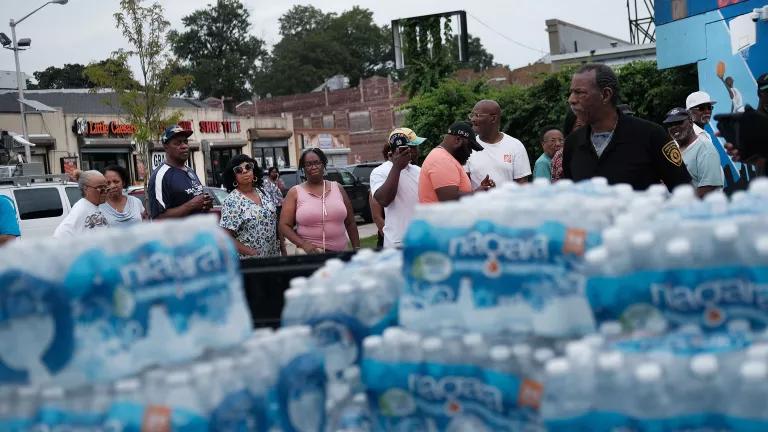On the 40th Anniversary of the Safe Drinking Water Act, Where We Were and Where We Are Going
This year marks the 40th Anniversary of the Safe Drinking Water Act. As part of the celebration, I participated in an event recently at the National Press Club to talk about the challenges ahead on dealing with emerging contaminants in drinking water. Below are the remarks that I prepared for that event.
And here you can see an archived video of all the remarks, including from EPA Administrator Gina McCarthy.
Back many years ago, I went to graduate school in another country. And I remember the first day walking into what they called the gyp or the tiny kitchen and seeing a sign above the faucet warning that the water wasn’t potable. I was amazed, because this wasn’t some small rural town in a developing part of the world struggling to find clean water – this was in Cambridge, England.
So, standing here today with the opportunity to reflect on what the Safe Drinking Water Act has done over the past 40 years to improve the quality of the tap water in this country – I acknowledge that it has accomplished a lot. We’ve come a long way. We are controlling the presence in this country’s tap water of a hundred-some contaminants from pesticides to industrial solvents to heavy metals. We have some of the safest water on a planet where almost a billion people do not have access to clean drinking water. And this is a great achievement.
But there is so much more we can and need to do. Even with these standards in place, too many public water systems continue to have significant health-based violations. We need to get these systems into compliance. And EPA needs to update and strengthen a lot of these standards. But it’s not just about the regulations we have in place now. While there are a hundred some contaminants regulated under the Safe Drinking Water Act, there are tens of thousands more that are in commerce that we don’t know about, aren’t testing or monitoring for, and aren’t regulating. Many are used in applications that allow them to get into sources of drinking water. The fracking industry is pumping secret (and not so secret) toxic chemicals underground and poisoning some aquifers and threatening others.
The problem is that the process put in place in the amendments to Safe Drinking Water Act nearly 20 years ago has effectively halted forward movement on figuring out what to do about all these chemicals. Just a couple of months ago, EPA announced only the first preliminary decision to regulate a chemical in drinking water in almost two decades. The. First. And EPA’s efforts to regulate perchlorate have been stalled for 4 years, blowing through statutorily mandated deadlines. It’s a travesty that this hallmark law has stagnated, exposing the public to potentially harmful contaminants in their drinking water.
Over the years, science has painted an increasingly grim picture of what many of these pervasive contaminants can do to our health after prolonged exposure. And the ballooning research on how many of these chemicals can interfere with the proper functioning of hormones at exquisitely low levels presents a particular issue for developing fetuses and young children. EPA’s current pace to address drinking water contaminants is simply not cutting it.
Just take a look at the list of unregulated contaminants and candidate contaminants: it reads like a who’s who of problem chemicals: perfluorinated compounds, 1,3-butadiene, formaldehyde.
And it doesn’t include other important contaminants: triclosan and triclocarban – the most prevalent chemicals used in antibacterial soaps and a plethora of other products; brominated and chlorinated flame retardants; antibiotic resistant bacteria.
There is too much at stake to be plodding along with this chemical-by-chemical approach. It is time to rethink how we protect our drinking water. EPA’s efforts at regulating a group of carcinogenic compounds at the same time is a good step towards streamlining the process, but again it has been almost four years without any actual proposed rule in place.
The framework for protecting our drinking water needs to change. The Administrator has too much discretion to determine whether to set a regulation. The barriers to developing the data to support regulation need to be lowered. The most toxic chemicals need to be stopped from getting into our source water or into commerce in the first place. Advanced treatment technologies that can eliminate wide swaths of contaminants while also dealing with taste and odor should be made more feasible and available.
Of course, it isn’t any one thing, and whatever the solutions are, we need to work on this all together. Time and again, I see polls ranking drinking water concerns as the top environmental concern among the general public. Dragging our feet, putting up barriers, focusing on how hard it is, or telling people that everything’s fine and to look the other way isn’t going to make it go away. People care about drinking water, and on this occasion of celebrating 40 years of the Safe Drinking Water Act, we owe it to the public and to ourselves to honestly examine its problems and start figuring out how to fix it.



